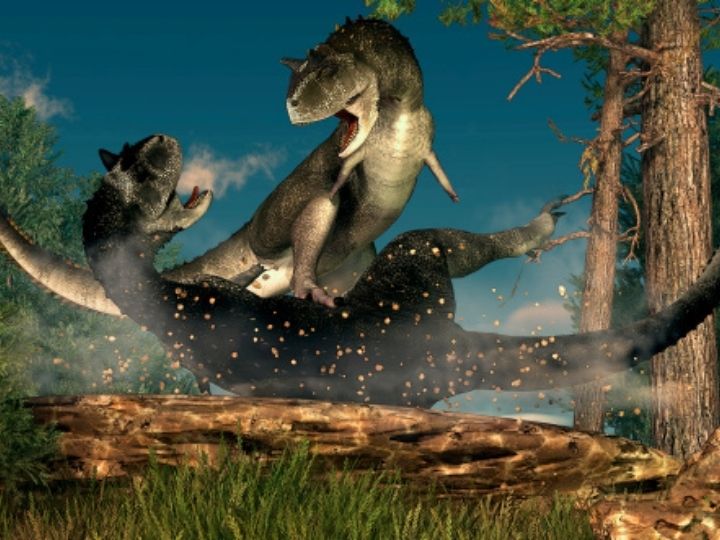This New Dinosaur Species Discovered In Argentina Was Armless, But Not Harmless
A team of researchers has discovered a new dinosaur in Argentina. The new species, named Guemesia ochoai, formed part of an array of 'unusual' creatures.

New Delhi: A team of researchers has discovered a new dinosaur in Argentina. The new species, named Guemesia ochoai, formed part of an array of 'unusual' creatures.
The description of the dinosaur, led by Argentinian researchers, was recently published in the Journal of Vertebrate Paleontology.
When Did The Newly Discovered Dinosaur Roam Earth?
Guemesia ochoai could be the close relative of the ancestors of an armless group of dinosaurs which roamed the southern hemisphere more than 70 million years ago, the study said. Guemesia ochoai could have looked similar to relatives such as Carnotaurus sastrei, which were theropod dinosaurs that lived in South America during the Late Cretaceous period, probably around 70 million years ago.

The researchers uncovered a partially complete skull in Argentina, which provides new evidence of a unique ecosystem during the Late Cretaceous. According to the study, Guemesia ochoai was a species of abelisaurid, a clade of dinosaurs which roamed what is now Africa, South America and India.
The dinosaur dates back to around 70 million years, and may have been a close relative of the ancestors of abelisaurid.
What Does The Dinosaur’s Skull Suggest?
Guemesia ochoai's skull was found in an area which has very few abelisaurid fossils, and the discovery offers a valuable insight into the region, the study said. Also, the new research may explain why the area gave rise to such unusual animals.
Professor Anjali Goswami, Research Leader at the Natural History Museum, United Kingdom, and co-author of the study, said that the new dinosaur is quite "unusual" for its kind, according to a statement issued by the Museum. She said that the dinosaur has several key characteristics which suggest that it is a new species. The newly discovered dinosaur provides important new information about an area of the world about which not a lot is known.
Goswami further said the discovery shows that the dinosaurs which live in this region were quite different from those in other parts of Argentina, supporting the idea of distinctive provinces in the Cretaceous of South America. She said that there is a lot more to be discovered in these areas that get less attention than some of the more famous fossil sites.
New Dinosaur Was Armless, But Not Harmless
All continents were combined together in the supercontinent, hundreds of millions of years ago. The supercontinent was known as Pangaea.
The tectonic plates shifted over time, and the landmass began to break into Gondwana and Laurasia.
Around 180 million years ago, the two massive continents started to split. Gondwana started breaking apart to form the major continents in the southern hemisphere, as well as India.
Therefore, the new continents were slowly moving apart. During this period, species would still have been able to move between them. Hence, some scientists suggested that the fauna of each landmass would have remained largely the same, according to the statement.
The study said that one of the groups living in Gondwana at the time were the abelisaurid dinosaurs. A group of top predatory theropods, abelisaurid dinosaurs may have fed on large dinosaurs such as titanosaurs. Despite this fearsome lifestyle, the abelisaurids were able to take down their massive prey without the use of arms, the study said.
Several species of abelisaurids had front limbs that were even shorter than those of the more famous Tyrannosaurus rex and effectively useless, which would have left abelisaurid hands unable to grasp, the study said.
The inability of abelisaurid hands to grasp something may have forced the dinosaurs to rely on their powerful heads and jaws to capture prey, according to the study.
Regions Where Fossils Of Such Dinosaurs Have Been Discovered
Fossils of these carnivores have been discovered in rocks across Africa, South America, India, and Europe dating to the Late Cretaceous. At the end of this epoch, 65 million years ago, an asteroid hit Earth in the Yucatan Peninsula, Mexico. The period ended with the extinction of dinosaurs, except birds, according to an article published by the University of California Museum of Paleontology, Berkeley, California.
Argentina is a country well known for abelisaur fossils. As many as 35 fossils have already been described there. According to the study, nearly all of these species are from Patagonia, in the country's south, and comparatively few of the dinosaurs have been found in the north-west.
The description of this new dinosaur species form part of a skull provides vital new knowledge for scientists researching this period of history, the study said.
Did The Dinosaur Have An Abelisaurid Ancestor?
The braincase, including the upper and back parts of the skull, was discovered in the Los Blanquitos Formation near Amblayo, according to the study. Amblayo is located in the north of Argentina, and the rocks dated to between 75 and 65 million years old. This implies that the animal lived just before the end-Cretaceous mass extinction which saw the extinction of most dinosaurs, the study said.
Unique Features Of The New Dinosaur
The researchers observed that one unique feature of the dinosaur are rows of small holes in the front of its skull known as foramina. The authors suggested in the study that the holes could have allowed the animal to cool down, with blood being pumped into the thin skin at the front of the head to release heat.
The skull has a 'remarkably small' braincase, similar to many abelisaurids. The study said that even then, the cranium of the new species was observed to be about 70 per cent smaller than any of its relatives. Though the reduced size may point to it being a juvenile, there is conflicting evidence on this.
There is a similar lack of clarity with respect to other features of the new dinosaur species. These include thin parts of the skull, and a lack of horns, the study said. Unlike other abelisaurids, the newly discovered skull is devoid of horns.
Who Is Guemesia ochoai Named After?
Though there is a lack of clarity about some of the details, there are enough unique features of the dinosaur to convince researchers that it is a new genus and species, which they named Guemesia ochoai, the study said. The dinosaur is named after General Martin Miguel de Güemes, a hero of the Argentine War of Independence, and Javier Ochoa, a museum technician who discovered the specimen, according to the study.
Many questions about the newly described abelisaurid remain unanswered. However, the discovery adds to a growing body of evidence suggesting that north-western Argentina had a unique set of creatures unlike those found elsewhere in the world at this time, according to the study.
The unique creatures include podocnemidoidae turtles such as Stupendemys geographicus, one of the largest aquatic reptiles to have ever lived, the study said.
Now, scientists hope to uncover more specimens of Guemesia ochoai and its relatives to find out more about life in ancient Argentina. The researchers are particularly focused on the period just before and after the end-Cretaceous mass extinction to understand how this massive event shaped life on Earth, according to the study.







































